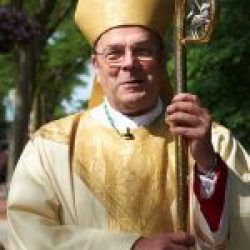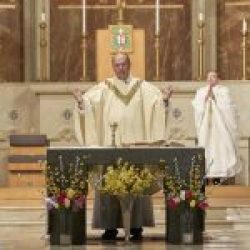On Saturday, April 15, I celebrated the Easter Vigil at the Cathedral of the Immaculate Conception. This night is the most blessed of all nights “when Christ broke the prison bars of death and rose victorious from the underworld” (Exsultet). The homily I preached on that occasion is printed below.
“. . . as the first day of the week was dawning, Mary Magdalen and the other Mary came to see the tomb.” Dawn breaks and two women visit Jesus’ tomb. Why do they go to the tomb? To remember their faithful companion and teacher? To draw near to Him in His death? To anoint His body? To see if His body is there? After all, Jesus had returned Lazarus to life. Could He not do the same for Himself?
As the women approach the tomb, the earth quakes, an angel rolls back the stone, and the guards are frozen in fear! The consoling words of the angel, “Do not be afraid . . . Jesus has been raised from the dead,” an appearance of Jesus and an assigned mission complete the Gospel scene. The Lord is risen, alleluia! He goes before us! We must go forth and announce this good news.
We are not hearing this story for the first time. The danger rests in being too familiar with it. When this happens, we may miss the grace of entering fully into the celebration.
We began this evening in darkness followed by a service of light with the blessing of the new fire and the lighting of the paschal candle. Christ the light dispels the darkness. The beautiful readings traced Israel’s history and the divine promise of deliverance from slavery and of a renewed heart and spirit. The baptism of our catechumens, the anointing with chrism, and the reception of the sacred Body and Blood of Christ, build up the Church and remind us all that Christ comes to meet us in the sacraments.
This night is the most blessed of all nights as we heard in the Exsultet, the Easter Proclamation. “This is the night when Christ broke the prison bars of death and rose victorious from the underworld. . . . The sanctifying power of this night dispels wickedness, washes guilt away, restores innocence to the fallen, and joy to mourners” (Exsultet).
A glorious future awaits us. St. Paul tells the Romans “. . . we who were baptized into Christ Jesus were baptized into his death. . . . If we have died with Christ, we believe that we shall also live with him” (Rm 6:3, 8). We must think of ourselves “as dead to sin and living for God in Christ Jesus” (Rm 6:11).
Jesus’ resurrection was not a resuscitation. He rose from the dead and lives in glory eternally. He is the resurrection and the life. Death has lost its sting. It has lost its hold on each of us. The death of the faithful is not an end but a change. Our death is a passage to new life. Eternal life awaits all of us. This is our Easter faith.
The women left the tomb, “fearful yet overjoyed,” and ran to announce the good news to the disciples. On their way, they met Jesus, embraced Him and “did him homage.” He sent them on their way. “Go tell my brothers to go to Galilee, and there they will see me.”
Easter brings us to the empty tomb. In its darkness and emptiness, we too hear the joyful message. “The Lord is risen. Alleluia!” In faith, we embrace the risen Lord. This is the day the Lord has made; let us rejoice and be glad. May we go forth in joy to announce this good news.
A blessed Easter to you and all whom you hold dear.
If you have a prayer intention you would like me to consider during the weeks ahead, please mail it to my attention at 240 E. Onondaga St., Syracuse, N.Y. 13202.






